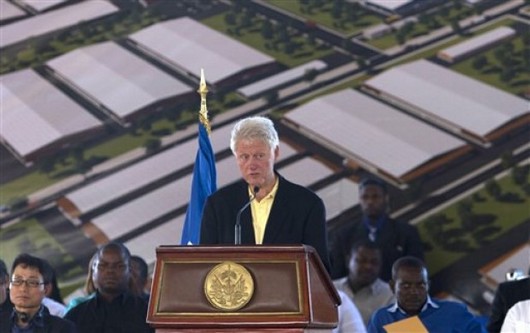The Haitian government is hosting Hillary and Bill Clinton, a delegation of foreign investors and a crowd of celebrities Monday to showcase the marquee project of the U.S. aid effort since the 2010 earthquake.

It’s an industrial park, more than a hundred miles from the slowly recovering quake zone. The Clintons and their allies hope the $300 million facility will transform the northern part of this impoverished country by providing thousands of desperately needed jobs.
Some Haitians have a sharply different view. They say the Caracol Industrial Park does little more than replicate failed efforts from the past and contend it will benefit outsiders more than Haitians. They also worry it will harm some of the few pieces of undamaged environment that still exist in Haiti.
The star turnout for the opening _ Sean Penn, who has run his own aid effort in Haiti, actor Ben Stiller and supermodel Petra Nemacova are among those expected to participate _ speaks to an eagerness to show concrete results in a country where progress is hard to find amid stalled reconstruction projects.
“It’s really all-in on this project, and there’s a high bar to deliver,” said Laurent Dubois, a historian who teaches at Duke University and is author of `’Haiti: The Aftershocks of History.” “It really needs to deliver in a big way so that people will think, yeah, this was the right thing to do.”
The stakes are high in large part because the Clintons have been so heavily involved.
The Caracol project was in the works before the earthquake but it became a top priority for the Obama administration soon after the disaster. Hillary Clinton’s chief of staff, Cheryl Mills, has made almost monthly visits to the site on Haiti’s northern coast.
Bill Clinton, the United Nations’ special envoy for Haiti, also took an interest. He attended the project’s groundbreaking a year ago with Haitian President Michel Martelly.
The $124 million put in by the U.S. makes the park Washington’s biggest single investment in the aftermath of the quake and it is certain to shape the legacy of the Clintons, who last visited Haiti together in 1975 on a wedding gift following their honeymoon in Mexico.
Monday’s trip is Hillary Clinton’s third to Haiti since the earthquake, and there have been more than a dozen visits by her husband, who was co-chairman of an earthquake recovery panel before its mandate ended a year ago.
The industrial park to be inaugurated by the Clintons was built on a 617-acre (250-hectare) site meant to “decentralize” Haiti’s economy away from the crowded capital of Port-au-Prince and help develop the long-neglected countryside.
The anchor tenant is South Korean apparel giant Sae-A Trading Co. Ltd, which begun production in May. It has agreed to create 20,000 permanent jobs within six years and also build 5,000 houses. Backers say the entire park has the potential to generate up to 65,000 jobs in all.
A local paint manufacturing company, Peintures Caraibes SA, became the second tenant in July and will export paint made by Sherwin Williams along with its own paint; production begins next month. It’s supposed to hire a total of 350 people.
Details are still being worked on to bring in other tenants, but the project’s architects hope its duty-free status and a 15-year tax holiday will lure more companies.
Everyone agrees Haiti needs jobs. The country of some 10 million people is among the poorest in the world, and unemployment and underemployment hover around 60 percent. The money earned by those lucky to find work is spread thin.
Despite the promises of up to 65,000 jobs at the site, and projections of possibly 133,000 more jobs through related cottage industries, the Caracol project has drawn heaps of skepticism.
Critics say it’s not much different from the factories to make baseballs for the U.S. sport that were built in the 1970s and 1980s under the regime of playboy dictator Jean-Claude “Baby Doc” Duvalier.
Those jobs prompted thousands of farmers to leave their fields for the capital, and agricultural areas succumbed to neglect. Shantytowns like Cite Soleil emerged to house the new workers. The factories got tax breaks but there was no income to offset Duvalier’s alleged plundering of state coffers.
Haiti was supposed to become the “Taiwan of the Caribbean” but instead it suffered through economic collapse brought on by political instability.
“This is: Been there, done that,” Alex Dupuy, a Haiti-born sociologist who teaches at Wesleyan University in Connecticut, said of the Caracol project.
Because of the tenants’ tax breaks, outside investors will have more to gain than Haitians, he said.
“This is not a strategy that is meant to provide Haiti with any measure of sustainable development … The only reason those industries come to Haiti is because the country has the lowest wages in the region,” Dupuy said.
Sae-A will pay employees Haiti’s minimum wage, which is $5 a day. Workers will be eligible for bonuses based on performance.
Hillary Clinton acknowledged the controversy associated with the project last month but argued that private enterprise strengthens economies.
“You cannot have development in today’s world without partnering with the private sector, and that has been our mantra, and we are now creating examples,” Clinton said at her husband’s Clinton Global Initiative in New York.
“Are there pitfalls? Are there problems? Of course there are _ there is with any kind of organized effort at development. But the fact is that including the private sector gives developing economies new opportunities.”
Backers of Caracol stress that it will bring tens of thousands of jobs to an area where subsistence farming has long been the only alternative to migration, and Jean Cherenfant, mayor of Cap-Haitien, a seaside city 13 miles (21 kilometers) from Caracol, is among them. He sees the facility as a boon for the region.
“We don’t have a lot of employers here, and we’re talking about several hundred thousand jobs,” Cherenfant said by telephone. “I will not go along with those people who are pessimistic.”
Proponents also say they are working to address potential problems. They say they have put money into multiple communities in the north in an effort to prevent Caracol from spawning shantytowns like the ones that sprang up in Port-au-Prince decades ago. The projects include new housing, road improvements and even help for farms.
Critics point to other pitfalls, including a threat to the environment. Several studies show there is elkhorn and staghorn coral at the mouth of a bay where proposals call for a new port that would make shipping easier for Caracol’s tenants.
Haiti’s government will ultimately decide where, and even if, a port is built. For now, the Manzanillo port in the neighboring Dominican Republic is being used, and it could remain the port if Haiti decides not to build one.





